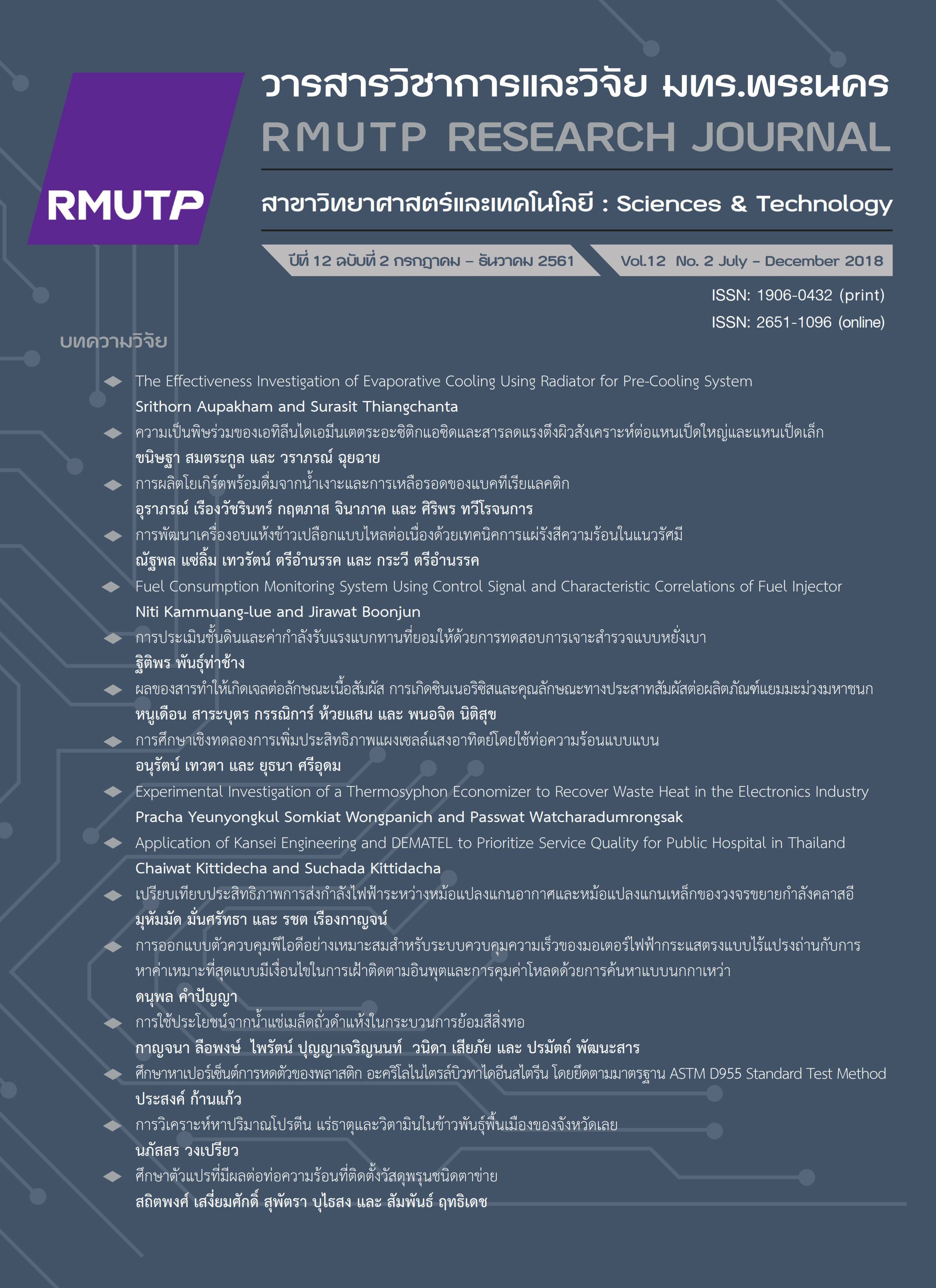ความเป็นพิษร่วมของเอทิลีนไดเอมีนเตตระอะซิติกแอซิดและสารลดแรงตึงผิวสังเคราะห์ต่อแหนเป็ดใหญ่และแหนเป็ดเล็ก
Main Article Content
บทคัดย่อ
การใช้งานสารคีเลตเอทิลีนไดเอมีนเตตระอะซิติกแอซิดหรืออีดีทีเอและสารลดแรงตึงผิวสังเคราะห์สูงขึ้นทำให้สารทั้งสองชนิดนี้มีโอกาสในการปนเปื้อนร่วมกันในแหล่งน้ำมากขึ้น ดังนั้นการศึกษานี้จึงได้ศึกษาความเป็นพิษต่อพืชร่วมกันของอีดีทีเอ 0 – 20 มิลลิกรัมต่อลิตร ร่วมกับสารลดแรงตึงผิวสังเคราะห์ 3 ชนิด คือไทรทรอนเอ็กซ์ 100 ทวีน 80 ที่ความเข้มข้น 0 – 10 เท่าของความเข้มข้นวิกฤตของการเกิดไมเซลล์ และโซเดียมโดเดซิลซัลเฟตที่ความเข้มข้น 0 – 2 เท่าของความเข้มข้นวิกฤตของการเกิดไมเซลล์ ต่อการเจริญเติบโตของแหนเป็ดใหญ่และแหนเป็ดเล็กเป็นเวลา 3 วัน ผลการศึกษาพบว่าความเป็นพิษต่อการเจริญเติบโตของแหนทั้งสองชนิดเกิดจากสารลดแรงตึงผิวเป็นหลัก ในขณะที่อีดีทีเอไม่เป็นพิษต่อการเจริญเติบโตของแหนทั้งสองชนิด โซเดียมโดเดซิลซัลเฟตเป็นพิษต่อแหนทั้งสองชนิดมากที่สุดโดยเฉพาะต่อปริมาณคลอโรฟิลล์ทุกชนิด ไทรทรอนเอ็กซ์ 100 เป็นพิษต่อการเจริญเติบโตของแหนเป็ดเล็กเท่านั้น ในขณะที่ทวีน 80 เป็นพิษน้อยที่สุด โดยส่งผลต่อปริมาณคลอโรฟิลล์เอและคลอโรฟิลล์ทั้งหมดของแหนเป็ดใหญ่และแหนเป็ดเล็กเท่านั้น แนวโน้มส่วนใหญ่ไม่พบปฏิสัมพันธ์ระหว่างอีดีทีเอกับสารลดแรงตึงผิวสังเคราะห์ ดังนั้น การปนเปื้อนสารลดแรงตึงผิวสังเคราะห์จึงเป็นสิ่งที่ต้องกังวลมากกว่าการปนเปื้อนร่วมกับอีดีทีเอ
Article Details
References
[2] Y. Huang and A.A. Keller, “EDTA functional magnetic nanoparticle sorbents for cadmium and lead contaminated water treatment,” Water Research, vol. 80, pp. 159-168, Sep. 2015.
[3] E. Bloem, S. Haneklaus, R. Haensch and E. Schnug, “EDTA application on agriculture soils affects microelement uptake of plants. Science of the Total Environment. Vol. 577, pp. 166-173, Jan. 2017.
[4] C. Oviedo and J. RodrÍguez, “EDTA: The chelating agent under environmental scrutiny,” Química Nova, vol. 26, pp. 901-905, Nov. 2003.
[5] F.G. Kari and W. Giger, “Speciation and fate of ethylenediaminetetraacetate (EDTA) in municipal wastewater treatment,” Water Research, vol. 30, pp. 122-134, Jan. 1996.
[6] R. Lanigan and T. Yamarik, “Final report on the safety assessment of EDTA, calcium disodium EDTA, diammonium DETA, dipotassium EDTA, disodium EDTA, TEA-EDTA, tetrasodium EDTA, trisodium EDTA, HEDTA and trisodium HEDTA,” International Journal Toxicology, vol. 21, pp. 95-142, Oct. 2002.
[7] O. Barrutia, C. Garbisu, J. Hernández-Allica, J.I. García-Plazaola and J.M. Becerril, “Diifereces in EDTA-assisted metal phytoextraxtion between matallicolous and non-metallicolous accessions of Rumex acetosa L.,” Environmental Pollution, vol. 158, pp. 1710-1715, May. 2010.
[8] J. Hernández-Allica, C. Garbisu, O. Barrutia and J.M. Becerril, “EDTA-induced heavy metal accumulation and phytotoxicity of cardoon plants,” Environmental and Experimental Botany, vol. 60, pp. 26-32, May. 2007.
[9] A.D. Vassil Y. Kapulnik I. Raskin and D.E. Salt, “The role of EDTA in lead transport and accumulation by Indian mustard,” Plant Physiology, vol. 117, pp. 447-453, Jun. 1998.
[10] S.E. Meers, M. Qadir, P. de Caritat, F.M.G. Tack, G.D. Laing and M.H. Zia, “EDTA-assisted Pd phytoextraction,” Chemosphere, vol. 74, pp. 12791291, Mar. 2009.
[11] M.J. Scott and M.N. Jones, “The biodegradation of surfactants in the environment,” Biochimica et Biophysica Acta (BBA) - Biomembranes, vol. 1508, pp. 235-251, Nov. 2000.
[12] E. Lowry, M. Sedghi and L. Goual, “Molecular simulations of NAPL removal from mineral surfaces using microemulsions and surfactants,” Colloids and Surfaces A: Physicochemical and Engineering Aspects, vol. 506, pp. 485-494, Oct. 2016.
[13] G.-G. Ying, “Fate, behavior and effects of surfactants and their degradation products in the environment,” Environment International, vol. 32, pp. 417-431, Apr. 2016.
[14] D. Feruzan, Y. Gülden, A. Halide, Ö Fatmanur and L. Sinem, “Phytotoxic effects of nonionic surfactant octylphenol series (Triton X-100, Triton X-114, Triton X-405) on onion.” Asian Journal of Chemistry, vol. 24, pp. 5746-5748, Dec. 2012.
[15] G. Chang, Q. Zhang, L. Zhang, Y. Lü and T. Gao, “Effect of sodium dodecyl sulfate on wheat (Triticum aestivum L.) seedlings,” Environmental Progress and Sustainable Energy, vol. 34, pp. 1142-1147, Feb. 2015.
[16] C. Forni, R. Braglia, F.J.M. Harren and S.M. Cristescu, “Stress response of duckweed (Lemna minor L.) and water velvet (Azolla filiculoides Lam.) to anionic surfactant sodium-dodecyl-sulphate (SDS),” Aquatic Toxicology, vol. 110-111, pp. 107-113, Apr. 2012.
[17] A.C. Agnello, D. Huguenot, E.D. van Hullebusch and G. Esposito, “Phytotoxicity of citric acid and Tween® for potential use as soil amendments in enhanced phytoremediation,” International Journal of Phytoremediation, vol. 17, pp. 669-677, Jan. 2015.
[18] Y. Gao, W. Ling, M.H. Wong, “Plant-accelerated dissipation of phenanthrene and pyrene from water in the presence of nonionic surfactant,” Chemosphere, vol. 63, pp. 1560-1567, Jun. 2006.
[19] M. Cheng, G. Zeng, D. Huang, C. Yang, C. Lai, C. Zhang and Y. Liu, “Advantage and challenges of Tween 80 surfactant-enhanced technologies for the remediation of soils contaminated with hydrophobic organic compounds,” Chemical Engineering Journal, vol. 314, pp. 98-113, Apr. 2017.
[20] HIS Markit [2015], “Specialty chemicals update program surfactants,” [Online]. Available from: https://www.ihs.com/products.chemical-surfactants-scup.html [Cited December 17, 2017]
[21] X.-D. Huang, Y. El-Alawi, D.M. Penrose, B.R. Glick and B.M. Greenberg, “Response of three grass species to creosote during phytoremediation,” Environmental Pollution, vol. 130, pp. 453-463, Aug. 2004.
[22] M.M. Singer and R.S. Tjeerdema, “Fate and effects of surfactant sodium dodecyl sulfate,” Reviews of Environmental Contamination and Toxicology, vol. 133, pp. 95-149, 1993.
[23] E.A.Solomonova and S.A. Ostroumov, “Tolerance of an aquatic macrophyte Potamogeton crispus L. to sodium dodecyl sulphate, “ Moscow University Biological Sciences Bulletin, vol. 62, pp. 176-170, Dec. 2007.
[24] W. Geebelen, J. Vangronsveld, D.C. Adriano, L.C. van Poucke and H. Clijsters, “Effects of Pb-EDTA and EDTA on oxidative stress reactions and mineral uptake in Phaseolus vulgaris,” Physiologia Plantarum, vol. 115, pp. 377-384, Jul. 2002.

